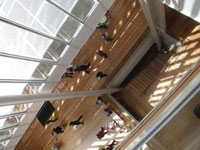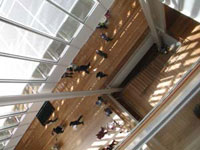by: Daniel Fox
Event: Brandism Series: Icon as Brand
Location: Center for Architecture, 02.26.07
Speakers: Mustafa Abadan, FAIA — partner, Skidmore, Owings & Merrill; James Biber, FAIA — partner, Pentagram; Mario Natarelli — Chief Brand Experience Officer, FutureBrand; Frank Sciame — President & CEO, F.J. Sciame Construction Company
Moderator: Ned Cramer — Editor-in-Chief, Architect
Organizers: Anna Klingmann, Assoc. AIA; AIA New York Chapter

Foster + Partners’ Hearst Headquarters.
Kristen Richards

The interior of the Morgan Library & Museum, designed by Renzo Piano Building Workshop.
Kristen Richards
Architects today receive commissions from more clients who value good design, thanks in part to the efforts of ascendant branding experts. Developers have realized that some buyers and tenants will pay premium rates to occupy space designed by a “name-brand” architect, just as museum directors and city officials have tried to harness the caché of star architects to attract tourists. As a result, a super-crop of signature buildings is surfacing on the streets of major cities. New York’s recent and imminent icons include the Morgan Library & Museum designed by Renzo Piano Building Workshop (RPBW) with Beyer Blinder Belle Architects and Planners; Hearst Headquarters by Foster + Partners; RPBW/ FXFOWLE Architects’ New York Times Building; Gehry Partners’ IAC Center; the four new towers at the World Trade Center site; and One Bryant Park designed by Cook + Fox Architects. Is the drive to produce signature architecture healthy for the profession and the built environment, or does branding ultimately erase construction quality?
“Icon-branded buildings make connections between culture and commerce by combining design and real estate logic,” according to Anna Klingmann, Assoc. AIA, organizer of the Brandism series hosted by the Center for Architecture. Magazines such as Wallpaper — that fuse fashion, products, and architecture into a chic digest of contemporary visual culture — whet the public’s growing appetite for good design. While Ned Cramer, Editor-in-Chief of Architect, observed that contemporary architecture still lags behind classical and pre-modern design in mainstream popularity (see the AIA’s recent survey of America’s Favorite Architecture), several highly branded, recent projects, including the Apple Store Fifth Avenue by Bohlin Cywinski Jackson, made the list shortly following their completion.
If the branding-industrial field has discovered how to create interesting new buildings and travel destinations, it has not solved the problem of how to encourage consistent quality, nor how to preserve the distinct integrity of its successes. Can a designer focus on the programmatic, social, and formal challenges at the site while trying to produce a ready-made icon? Mustafa Abadan, FAIA, a partner at SOM currently working on the totemic Burj Dubai, says it’s not impossible. He described the development of the AOL Time Warner Center at Columbus Circle as an organic process of spatial problem-solving resulting in a striking final product. Yet he warns against a city resembling an overcrowded cosmetics store with opulent bottles jostling for attention.
James Biber, FAIA, an architect with the design and branding firm Pentagram, distinguished between architecture that revealed an “honest” brand identity, and superficial glitz amounting to an “advertising lie.” Mario Natarelli, whose firm FutureBrand is commissioned to strategically define cities, countries, and governments as well as companies and buildings, defines brand as a kind of relationship between seller and buyer. He agreed with an audience member that good branding is not synonymous with good architecture: “You can’t spin a building to be any better than it’s going to be.”
Gideon Fink Shapiro is a writer and researcher at Gabellini Sheppard Associates, and contributes to several design publications.











